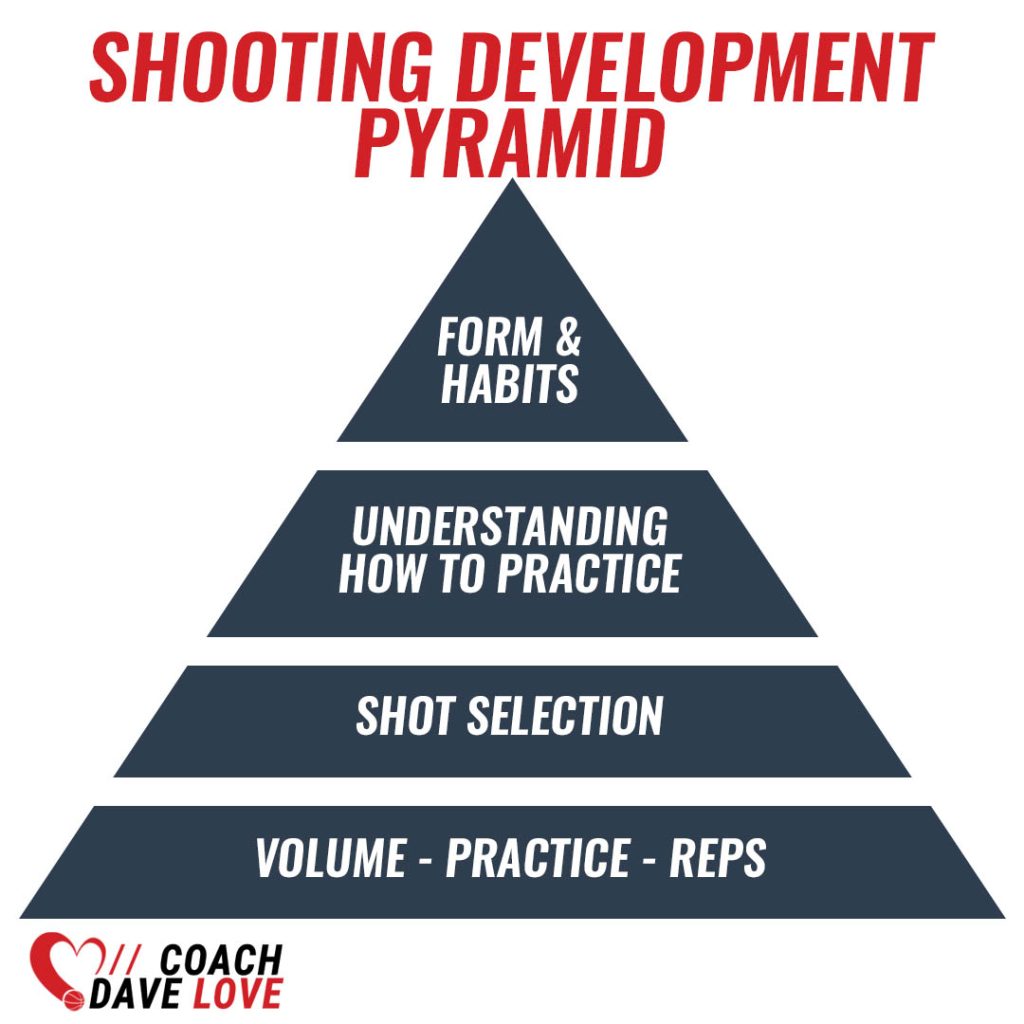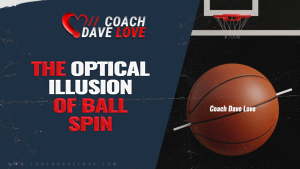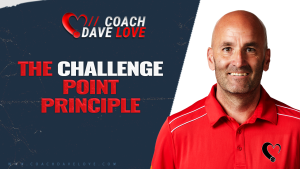In the world of basketball, shooting stands as a pillar of athletic prowess, capable of transforming players into true game-changers. Despite its pivotal role, many players and coaches navigate the complexities of shooting development without a clear roadmap.
In this pursuit of shooting excellence, potential pitfalls are everywhere. Often, emphasis is misplaced, with attention diverted from fundamental principles to peripheral aspects of the craft, or overemphasis is put in area when that time can be best used elsewhere. To address this, I introduce the “Shooting Development Pyramid” — a structured framework designed to illuminate the path towards shooting proficiency.
At its core, this pyramid embodies a simple yet profound truth: not all facets of shooting development are equal. Some elements serve as the bedrock of skill enhancement, while others, though valuable, pale in comparison to the essentials. By delineating these levels of importance, the pyramid provides a compass for prioritization in training regimens and player development strategies.

The Foundation: Reps, Volume and Practice
At the bedrock of shooting development lies a principle as simple as it is immutable: repetition. In the quest for shooting mastery, the most basic prerequisite is that players must get in the gym and shoot. Without the consistent repetition of shooting mechanics, players find themselves adrift in a sea of potential, never fully realizing their capabilities.
Consider the testimony of some of the great shooters I’ve asked the same question, “who has shot more shots than you?” — from Kyrie Irving to Steve Nash, from collegiate stars to rising youth phenoms — each echoes the same refrain: no one was in the gym more regularly or getting more shots on a consistent basis. Regardless of background or journey, the common denominator among elite shooters is a willingness to put in the work. They honed their craft not in the glare of stadium lights, but in the solitude of countless hours spent shooting.
The significance of this foundation cannot be overstated. It transcends nuances of form or technique, reaching to the very core of shooting proficiency. For in the absence of volume, all other efforts falter. No amount of refinement can compensate for a lack of repetitions over a long period of time.
“Repetition is the bedrock of shooting development. Without consistent practice, improvement is merely a mirage.”
If you find yourself with limited resources, whether constrained by time or expertise, the prescription remains clear: encourage players to shoot, relentlessly and without reservation. It was not complex drills or elaborate training regimens that distinguished the great shooting teams of history, but rather a commitment to the simple act of shooting itself.
In its purest form, the foundation of shooting development is laid bare: the more shots taken, the greater the potential for improvement. While refinement and specificity have their place, they are simply enhancements to repetition.
The shooting landscaped is littered with people with unusual form, or lacking resources, but they were able to overcome with an overwhelming volume.
Ground Floor: Shot Selection
Having laid the foundation of shooting development with the relentless pursuit of repetitions, the next level of refinement beckons: shot selection. While the sheer volume of shots provides starting point for future success, no player will become great if they take too many bad shots.
At its essence, shot selection embodies a fundamental truth: proficiency in shooting is only as valuable as the quality of the shots attempted. A player or team may amass a trove of shooting opportunities, but without discrimination, their efforts are destined to yield diminishing returns.
Shot selection manifests in both personal and universal dimensions. On a personal level, it entails an intimate understanding of one’s own capabilities and limitations. Recognizing which shots align with individual strengths and which shots might be too difficult for their current abilities might offer very quick returns. Moreover, it necessitates the humility to pass on shots that fall outside the realm of proficiency, instead opting to create a better shot for their teammates, trusting their teammates will do the same for them.
Yet, shot selection extends beyond the confines of individual prowess, encompassing a macroscopic view of basketball’s strategic landscape. At this level, players must grasp the hierarchy of shot values, discerning between the invaluable and the expendable. Lay-ups, dunks, and free throws emerge as the gold standard for valuable shots at most levels. Close behind are open, catch-and-shoot threes, while long, contested twos tend to be the least valuable shot regardless of the level of team or player.
“Shot selection is the art of maximizing value on the court. It’s not just about taking shots, but taking the right shots that give you and your team the best chance for success.”
Armed with this dual understanding — of personal proficiency and strategic significance — players embark on a journey of disciplined decision-making. They should avoid the allure of low-percentage shots in favor of those that promise a higher return on investment.
Upper Levels: Learning How to Practice
As we progress through the levels of shooting development, we encounter an area ripe with potential: practice habits. A place where players and coaches alike can harness the power of deliberate practice and skill acquisition principles to elevate their shooting skills.
It’s crucial to address a common misconception: the idea that mindless repetition leads to improvement. Many have fallen into the trap of block practice, where drills are repeated mechanically and without thought. However, this approach fails to cultivate the nuanced skills necessary for shooting mastery.
The solution lies in embracing deliberate practice within game-like scenarios. Here, players confront the challenge point — the delicate balance between difficulty and skill acquisition. True growth occurs as they navigate the complexities of variability and adaptability inherent in the game.
“Smart practice is the secret sauce of shooting improvement. HOW you practice is the gasoline on the fire of development.”
No longer confined to traditional form shooting drills, players and coaches are urged to explore various practice modalities, from Differential Learning to Constraints Based Drills.
Furthermore, it’s essential to tailor practice to meet the specific needs of players and teams. Practice must be purposeful and intentional, with each opportunity leveraged to foster growth and adaptation.
This journey towards refined practice habits isn’t without its challenges. It demands a willingness to challenge entrenched beliefs and embrace the discomfort of growth. Players unlock new depths of skill and adaptability, while coaches uncover the keys to unlocking their team’s full potential.
Top of the Pyramid: Shooting Form or Mechanics
As we reach the summit of the shooting development pyramid, it’s time to reassess our perspective. Here, amidst the intricacies of shooting mechanics, a crucial truth emerges: while form is important, its significance pales in comparison to other aspects of shooting improvement.
This assertion may sound surprising, especially coming from a shooting coach. However, it’s grounded in experience. The relentless pursuit of perfect form often leads to diminishing returns. Players and coaches get caught up in the quest for an ideal that’s impossible to achieve, resulting in rigid mechanics that hinder adaptability on the court.
“Form is important, but adaptability is paramount. It’s not about chasing perfection, but about being able to adjust to any situation.”
Rather than chasing perfection, players should prioritize simplicity and repeatability in their approach to shooting development. By focusing on a few key principles that yield tangible results, players can enhance their shooting proficiency without becoming slaves to an unattainable standard.
The essence of shooting mechanics lies not in achieving flawless form, but in cultivating adaptability. Players must learn to wield their mechanics as flexible tools, capable of adapting to the ever-changing demands of the game. True shooting mastery is forged in this crucible of adaptability.
As players and coaches reach the pinnacle of the shooting development pyramid, let them remember: form is just one piece of the puzzle. To truly excel, they must prioritize simplicity, adaptability, and effectiveness over the allure of perfection. It’s through this relentless pursuit of these principles that the essence of shooting mastery is revealed.
Conclusion
As we conclude our exploration of the Shooting Development Pyramid, one truth becomes abundantly clear: the path to shooting mastery is diverse and challenging. It involves more than simply standing at the top of the key working on a habit over and over. From the fundamental principles of repetition to the nuanced strategies of shot selection, from refining practice habits to mastering shooting mechanics, each level of the pyramid offers a gateway to untapped potential on the court.



